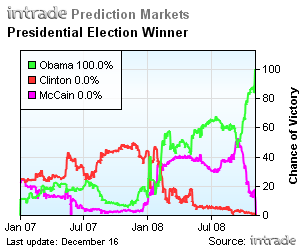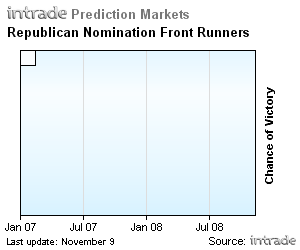ABSTRACT: In the last 2.5 years, Google has conducted the largest corporate experiment with prediction markets we are aware of. In this paper, we illustrate how markets can be used to study how an organization processes information. We document a number of biases in Google’s markets, most notably an optimistic bias. Newly hired employees are on the optimistic side of these markets, and optimistic biases are significantly more pronounced on days when Google stock is appreciating. We find strong correlations in trading for those who sit within a few feet of one another- social networks and work relationships also play a secondary explanatory role. The results are interesting in light of recent research on the role of optimism in entrepreneurial firms, as well as recent work on the importance of geographical and social proximity in explaining information flows in firms and markets.
–
DISCUSSION: In the past few years, many companies have experimented with prediction markets. In this paper, we analyze the largest such experiment we are aware of. We find that prices in Google’s markets closely approximated event probabilities, but did contain some biases, especially early in our sample. The most interesting of these was an optimism bias, which was more pronounced for subjects under the control of Google employees, such as would a project be completed on time or would a particular office be opened. Optimism was more present in the trading of newly hired employees, and was significantly more pronounced on and immediately following days with Google stock price appreciation. Our optimism results are interesting given the role that optimism is often thought to play in motivation and the success of entrepreneurial firms. They raise the possibility of a “stock price-optimism-performance-stock price” feedback that may be worthy of further investigation. We also examine how information and beliefs about prediction market topics move around an organization. We find a significant role for micro-geography. The trading of physically proximate employees is correlated, and only becomes correlated after the employees begin to sit near each other, suggesting a causal relationship. Work and social connections play a detectable but significantly smaller role.
An important caveat to our results is that they tell us about information flows about prediction market subjects, many of which are ancillary to employees’ main jobs. This may explain why physical proximity matters so much more than work relationships – if prediction market topics are lower-priority subjects on which to exchange information, then information exchange may require the opportunities for low-opportunity-cost communication created by physical proximity. Of course, introspection suggests that genuinely creative ideas often arise from such low-opportunity-cost communication. Google’s frequent office moves and emphasis on product innovation may provide an ideal testing ground in which to better understand the creative process.
–
PAPER BODY: In the last 4 years, many large firms have begun experimenting with internal prediction markets run among their employees. The primary goal of these markets is to generate predictions that efficiently aggregate many employees’ information and augment existing forecasting methods. […] In this paper, we argue that in addition to making predictions, internal prediction can provide insight into how organizations process information. Prediction markets provide employees with incentives for truthful revelation and can capture changes in opinion at a much higher frequency than surveys, allowing one to track how information moves around an organization and how it responds to external events. […]
We can draw two main conclusions. The first is that Google’s markets, while reasonably efficient, reveal some biases. During our study period, the internal markets overpriced securities tied to optimistic outcomes by 10 percentage points. The optimistic bias in Google’s markets was significantly greater on and following days when Google stock appreciated. Securities tied to extreme outcomes were underpriced by a smaller magnitude, and favorites were also overpriced slightly. These biases in prices were partly driven by the trading of newly hired employees- Google employees with longer tenure and more experience trading in the markets were better calibrated. Perhaps as a result, the pricing biases in Google’s markets declined over our sample period, suggesting that corporate prediction markets may perform better as collective experience increases.
The second conclusion is that opinions on specific topics are correlated among employees who are proximate in some sense. Physical proximity was the most important of the forms of proximity we studied. Physical proximity needed to be extremely close for it to matter. Using data on the precise latitude and longitude of employees’ offices, we found that prediction market positions were most correlated among employees sharing an office, that correlations declined with distance for employees on the same floor of a building, and that employees on different floors of the same building were no more correlated than employees in different cities.4 Google employees moved offices extremely frequently during our sample period (in the US, approximately once every 90 days), and we are able to use these office moves to show that our results are not simply the result of like-minded individuals being seated together. […]
Our findings contribute to three quite different literatures: on the role of optimism in entrepreneurial firms, on employee communication in organizations, and on social networks and information flows among investors. […]
The lessons of the literature informed Google CEO Eric Schmidt and Chief Economist Hal Varian’s (2005) third rule for managing knowledge workers: “Pack Them In.” Indeed, the fact that Google employees moved so frequently during our sample period suggests that considerable thought is put into optimizing physical locations. To this literature, which has largely relied on retrospective surveys to track communication, we illustrate how prediction markets can be used as high-frequency, market-incentivized surveys to track information flows in real-time. […]
Google’s prediction markets were launched in April 2005. The [Google prediction] markets are patterned on the Iowa Electronic Markets (Berg, et. al., 2001). In Google’s terminology, a market asks a question (e.g., “how many users will Gmail have?”) that has 2-5 possible mutually exclusive and completely exhaustive answers (e.g., “Fewer than X users”, “Between X and Y”, and “More than Y”). Each answer corresponds to a security that is worth a unit of currency (called a “Gooble”) if the answer turns out to be correct (and zero otherwise). Trade is conducted via a continuous double auction in each security. As on the IEM, short selling is not allowed– traders can instead exchange a Gooble for a complete set of securities and then sell the ones they choose. Likewise, they can exchange complete set of securities for currency. There is no automated market maker, but several employees did create robotic traders that sometimes played this role.
Each calendar quarter from 2005Q2 to 2007Q3 about 25-30 different markets were created. Participants received a fresh endowment of Goobles which they could invest in securities. The markets’ questions were designed so that they could all be resolved by the end of the quarter. At the end of the quarter, Goobles were converted into raffle tickets and prizes were raffled off. The prize budget was $10,000 per quarter, or about $25-100 per active trader (depending on the number active in a particular quarter). Participation was open to active employees and some contractors and vendors– out of 6,425 employees who had a prediction market account, 1,463 placed at least one trade. […]
Common types of markets included those forecasting demand (e.g., the number of users for a product) and internal performance (e.g., a product’s quality rating, whether a product would leave beta on time). […]
In addition, about 30 percent of Google’s markets were so-called “fun” markets –markets on subjects of interest to its employees but with no clear connection to its business (e.g., the quality of Star Wars Episode III, gas prices, the federal funds rate). Other firms experimenting with prediction markets that we are aware of have avoided these markets, perhaps out of fear of appearing unserious. Interestingly, we find that volume in “fun” and “serious” markets are positively correlated (at the daily, weekly, and monthly frequencies), suggesting that the former might help create, rather than crowd out, liquidity for the latter. […]
Google’s prediction markets are reasonably efficient, but did exhibit four specific biases: an overpricing of favorites, short aversion, optimism, and an underpricing of extreme outcomes. New employees and inexperienced traders appear to suffer more from these biases, and as market participants gained experience over the course of our sample period, the biases become less pronounced. […]
–
FOOT NOTE: One trader in Google’s markets wrote a trading robot that was extremely prolific and ended up participating in about half of all trades. Many of these trades exploited arbitrage opportunities available from simultaneously selling all securities in a bundle. In order to avoid having this trader dominate the (trade-weighted) results in Table 9, we include a dummy variable to control for him or her. None of the results discussed in the above paragraph are sensitive to removing this dummy variable.
–
APPENDIX:


![]()
![]()































